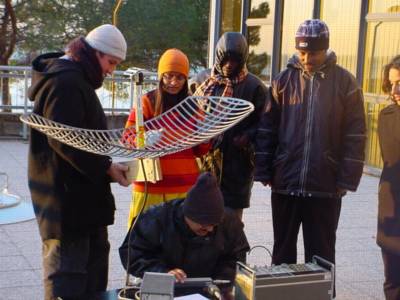
 |
HomePage | Handbook |
| Download | WebLinks | |
| Updates | Contact |

|
Radio Laboratory Handbook 2004.Recently, modern radio has generated much interest because of its potential to facilitate access to the global information infrastructure, and to close the digital divide as named it Kofi Annan, the UN Secretary General. Many projects have been launched to solve the problem, but without active involvement of young scientists and engineers in developing countries, without wide dissemination of the know-how, there is no hope to bridge the digital gap in the foreseeable future. Training activities on digital radio have been initiated at ICTP schools and colleges, some of which were carried out in collaboration with other entities, such as the International Union of Radio Science URSI , and the International Telecommunication Union Telecommunication Development Bureau ITU/BDT . These activities included tutorial lectures and laboratory work, where both computer networking and innovative digital radio techniques were experienced by some 1500 participants from all the continents since 1996. As a result, a series of concrete ICT projects have been initiated, developed and successfully completed in Nigeria, Sudan, Benin, Ghana and Romania. This book was prepared for the participants in the 2004 School on Digital Radio Communications for Research and Training in Developing Countries, but also other people may found it useful. Following the request of the participants, the school program is focused on innovative solutions in design and implementation of 2.4 GHz low-cost wireless local area networks (WLANs) not only interconnecting computers, but also offering data, audio, and video communications at distances up to about 25 kilometers. The goal is to provide the participants with knowledge and skills needed to setup wireless networks for campus WLANs and links to remote internet service providers, using modest resources available locally in their home countries. Much of the school time is thus devoted to hands-on sessions of antenna building, installation, testing and measurements, and this volume guides through these activities step-by-step. The book contains also some theoretical background and bases on the experience the authors gained at the previous schools and elsewhere. The contents of this volume will be available also on CDROM and at the webpage http://wireless.ictp.trieste.it. It will be complemented by other teaching material and documentation, tutorials, and open source software, as well as by reviews of the state-of-the-art technologies and will be updated from time to time. The free on-line access to lecture notes, hands-on guides, manuals and tutorials from previous schools has already enjoyed a daily average of some 450 visits and 260 MB of data retrieved. We hope that the 2004 school and this material will contribute to advancing scientific development in academic and research institutions in Developing Countries, and it is up to the scientists and professors employed there to make use of information offered and to disseminate it further. Comments on this book and on the school can be submitted to sandro.radicella@ictp.trieste.it Prof. Dr. Sandro M. Radicella, Co-Director of the School Prof. Dr. Ryszard Struzak, Co-Director of the School |